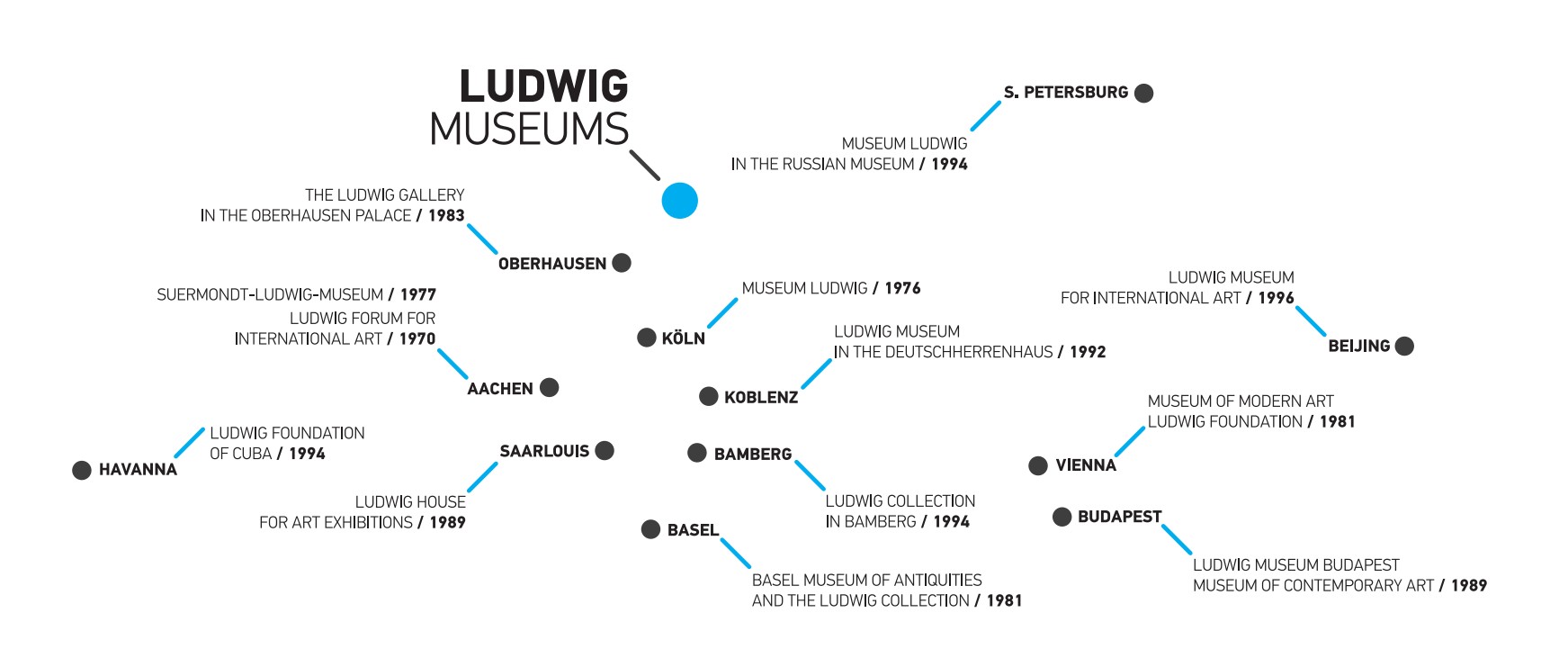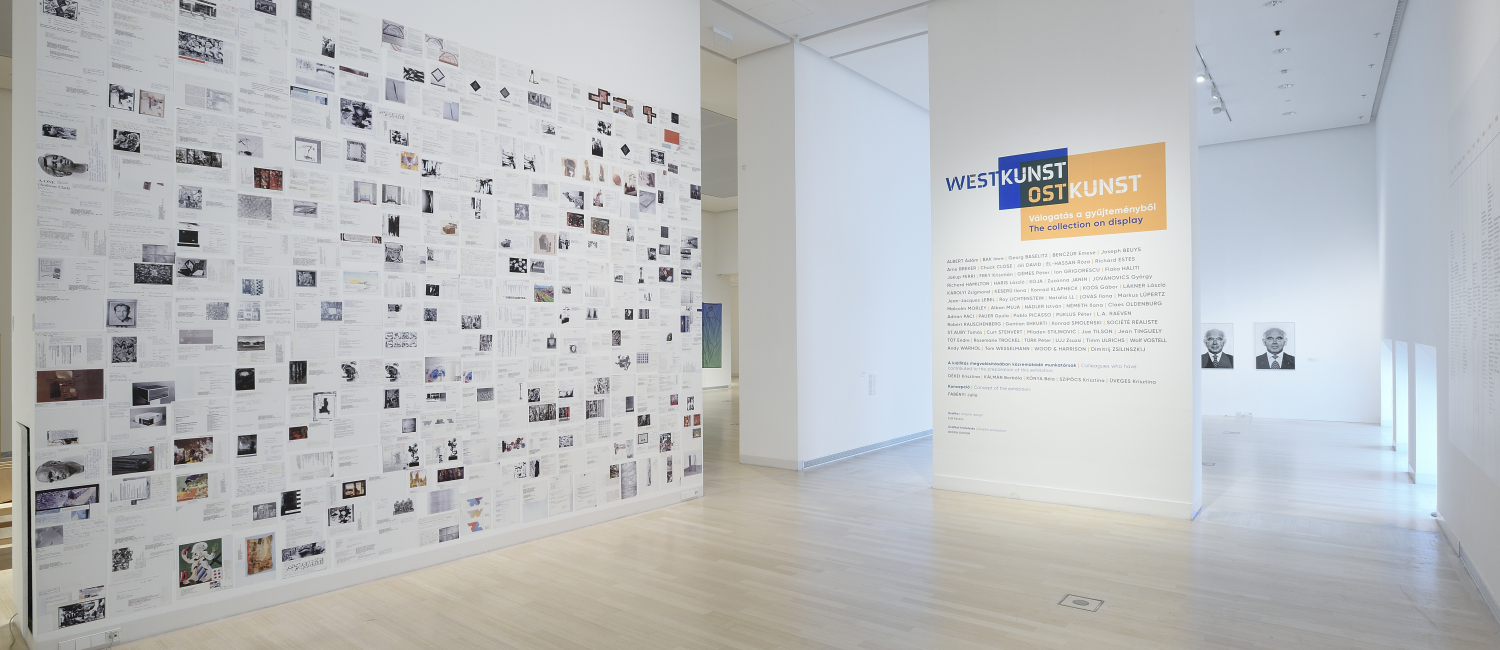
Suermondt - Ludwig Museum, Aachen
In 1977, Irene and Peter Ludwig donated an important collection of Medieval and Modern Art to the municipal institution founded in 1883, which has since been known under its new name "Suermondt-Ludwig-Museum.“ In 1992, construction works began to extend the existing building which was completed in 1994. The Ludwig donation comprises paintings and sculptures, ranging from Romanesque colonnade sculptures and works by Jan Vermeer van Haarlem the Elder (1628-1695) to the modern paintings of Hans Hartung (1904-1989), as well as applied art such as reliquary shrines, family altar pieces, monstrances, communion chalices and sacral textiles. In addition, the museum houses superb, well preserved glass paintings, lead glazings from the Cologne Cathedral originating from the 13th century, window fragments and details from Jan Thorn-Prikker (1868-1932) and many more treasures.
The Ludwig International Art Forum, Aachen
Since 1991, the Ludwig International Art Forum has been located in a repurposed umbrella factory from the 1920s. This municipal museum is the successor of an earlier institution, the “Neue Galerie – Sammlung Ludwig,” which opened in Aachen in February, 1970. The foundation of the Ludwig Forum has meant not only the extension of the permanent exhibition but also the enrichment of the temporary exhibitions and cultural events of the “Neue Galerie – Sammlung Ludwig.“ In June, 2000, Irene Ludwig donated an additional 68 works of contemporary art to the Ludwig Forum and thus to the city of Aachen (previously, these works have only been long-term loans).
Ludwig Collection in Bamberg
In 1994, a "cooperation agreement“ was signed between the City of Bamberg and Irene und Peter Ludwig. The outstanding faïence and porcelain holdings of the Ludwig Collection were given as a permanent loan to the City of Bamberg and have been exhibited since 1995 in the "Old Bridge Town Hall,“ a municipal institution. The Baroque building is exemplary for the entire townscape. In addition to its function as a museum, the building is used for official representative purposes, with its Rococo hall serving for receptions. The collection of approximately 300 works of art provides an exquisite range of Meissen porcelain, as well as Strassbourg faïence and a variety of objects from various other manufacturers.
Basel Museum of Antiquities and The Ludwig Collection
The cooperation between Irene and Peter Ludwig and the cantonal "Basel Museum of Antiquities“ began in the early 1970s. Although the Museum predominantly houses works of Greek origin, there are also Italian, Etruscan and Roman artefacts from the third millennium BC to AD 300. In 1981, the Ludwigs donated a collection of 200 antiquities to the City of Basel. This significant expansion of the existing collection prompted the construction of a museum extension, which was completed in 1988. Also in 1988, the Ludwigs made a considerable number of permanent loans to the Museum. The donation and permanent loans from the collection of Irene and Peter Ludwig comprise a wide range of Geometric, Corinthian and Attic vases, Tarentine terracotta works and antefixes, as well as bronze and marble sculpture.
Museum of Modern Art Ludwig Foundation, Vienna
In 1962, the “Museum of the 20th Century“ opened in a former Expo Pavilion and in 1979, the “Museum of Modern Art“ opened at the Palais Liechtenstein with a presentation from the Ludwig Collection. In 1981, the “Austrian Ludwig Foundation for Art and Science“ was established in association with the donation of 120 masterpieces from American and European artists representing the period after 1945. In 1991, a second donation was made to the “Austrian Ludwig Foundation,“ including works by artists from the United States, France, Hungary, Russia, Bulgaria, Colombia, Italy, Great Britain and Germany. Both exhibition buildings were united under the new name “Museum of Modern Art Ludwig Foundation.“ Today, it is one of the most important museums of modern art in Central Europe.
In the summer 2001, prior to the relocation of the "Ludwig Museum of Modern Art" into the Museum district, the term “MUMOK” was officially introduced. Through MUMOK's relocation it was possible to realize the long-planned joining of the institution's two separate buildings. Since September 2001 the new construction houses the exhibit of modern and contemporary art.
Museum Ludwig, Köln
In 1976, the donation of approximately 300 works of art from the collection of Irene and Peter Ludwig prompted the foundation of the "Museum Ludwig.“ With this, the City of Cologne created an independent institution for the art of the 20th century, whereby the significant Modern Art Collections of the Wallraf Richartz Museum, especially the Haubrich Collection of German Expressionism, were integrated into the new museum. The new and highly impressive building near the Cologne Cathedral was completed in 1986 and also houses the Cologne Philharmonic Hall and the Wallraf Richartz Museum. The works of art from the Ludwig Collection are focused around three central themes. The Museum holds, for example, the most comprehensive collection of early Russian Avant-Garde artworks outside of Russia. In addition, American and British Pop Art is represented by countless examples of outstanding importance. In 1994, Irene and Peter Ludwig made a spectacular donation of 90 works by Pablo Picasso. This was complemented by additional loans of works by the Spanish master. Finally, the museum also boasts a significant collection of Contemporary German Art of excellent quality.
Ludwig Museum im Deutschherrenhaus, Koblenz
Since 1992, the municipal "Ludwig Museum“ in Peter Ludwig’s home town of Koblenz is located in the Deutschherrenhaus, a former bastion of the Teutonic Order of Knights from the 13rd century. The building now offers four storeys for the presentation of the collection and for special exhibitions. As early as 1985, a committee of specialists agreed to place the primary emphasis of the new museum on Western European art, with a particular concentration on contemporary art from France.
The Ludwigs’ donation of a number of outstanding artworks, complemented by the extensive amount of objects on long-term loan, form the basis of this museum with its international agenda. The goal of the museum is to provide a vivid impression of the contemporary art scene in France. The collection concentrates on the period from 1945 to today’s progressive trends and comprises works by Pablo Picasso, Jean Dubuffet, Wols, Pierre Soulages and Serge Poliakoff as the leading exponents of Classical Modern Art in France. These are complemented by works from the "Nouveaux Réalistes“ and the "Figuration libre“ movement.
The Ludwig Gallery in the Oberhausen Palace
The Ludwig Gallery in the Oberhausen Palace is a special institution in the world-wide circle of museums connected with the name Ludwig. In an exhibition area of 1500 square metres, it presents annual thematic exhibitions of old and new art works from the Ludwig Collection. In addition, the exhibition activities focus on the interrelationship between high art and trivial art. Since 1983, the Oberhausen Palace has housed the “Ludwig Institute for the Art of the German Democratic Republic.“ Following extensive renovation works, the municipal institution was reopened in 1998 under its new name: “The Ludwig Gallery in the Oberhausen Palace“ with innovative art and educational programmes.
Ludwig Museum for International Art, Beijing
The most recent museum foundation initiated by Irene and Peter Ludwig took place in November 1996 with the founding of the "Ludwig Museum for International Art Beijing,“ based on an agreement drawn up between the Ministry of Culture of the People’s Republic of China, the Chinese National Museum and the collectors Irene and Peter Ludwig. The collectors Irene and Peter Ludwig donated a significant number of international works of art to the museum, created by artists of international reputation, including Georg Baselitz, Gerhard Richter, Nancy Graves, Renato Guttuso, David Hockney, Jasper Johns, Anselm Kiefer, Roy Lichtenstein, Natalia Nesterowa, Pablo Picasso, Andy Warhol and Tom Wesselmann, to name a few only, have been associated with the Chinese National Museum. Since December 1999, the art works have been touring through various provinces in China.
Ludwig House for Art Exhibitions, Saarlouis
The “Ludwig House for Art Exhibitions“ was established in Saarlouis in 1989. The prestigious building from the late 19th/early 20th century was converted into a three-storey gallery, presenting varied exhibitions of international works of both Eastern and Western Art from the collection of Irene and Peter Ludwig. The exhibitions in this municipal institution are organized in cooperation with the “Ludwig Gallery in the Oberhausen Palace.“
Museum Ludwig in the Russian Museum, St. Petersburg
The “Museum Ludwig in the Russian Museum“ was founded by Irene and Peter Ludwig in 1994. Following a donation of 118 works of international and Russian Modern Art, it was opened to the public in 1995 in St. Petersburg’s Marble Palace, one of the city’s most renowned architectural monuments, dating from the second half of the 18th century. The “State Russian Museum“ is now able to continue pursuing its traditional goal of leading the dialogue between Russian art and the art of the rest of the world. Works by artists from various countries and continents, including Russian artists, are displayed together under one roof in a permanent exhibition.
